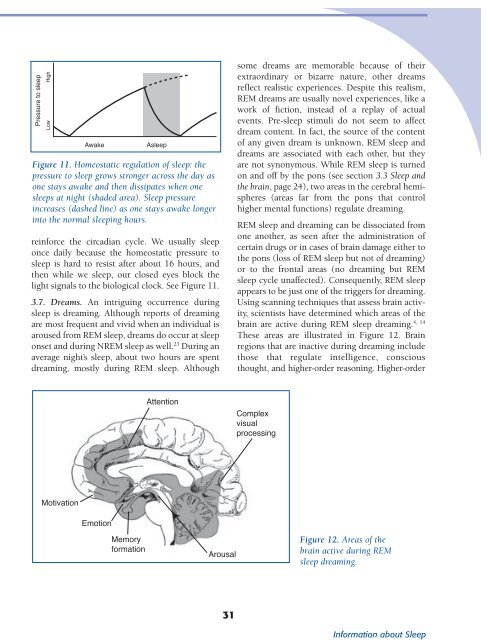Biological - NIH Office of Science Education - National Institutes of ...
Biological - NIH Office of Science Education - National Institutes of ...
Biological - NIH Office of Science Education - National Institutes of ...
You also want an ePaper? Increase the reach of your titles
YUMPU automatically turns print PDFs into web optimized ePapers that Google loves.
Figure 11. Homeostatic regulation <strong>of</strong> sleep: the<br />
pressure to sleep grows stronger across the day as<br />
one stays awake and then dissipates when one<br />
sleeps at night (shaded area). Sleep pressure<br />
increases (dashed line) as one stays awake longer<br />
into the normal sleeping hours.<br />
reinforce the circadian cycle. We usually sleep<br />
once daily because the homeostatic pressure to<br />
sleep is hard to resist after about 16 hours, and<br />
then while we sleep, our closed eyes block the<br />
light signals to the biological clock. See Figure 11.<br />
3.7. Dreams. An intriguing occurrence during<br />
sleep is dreaming. Although reports <strong>of</strong> dreaming<br />
are most frequent and vivid when an individual is<br />
aroused from REM sleep, dreams do occur at sleep<br />
onset and during NREM sleep as well. 23 During an<br />
average night’s sleep, about two hours are spent<br />
dreaming, mostly during REM sleep. Although<br />
some dreams are memorable because <strong>of</strong> their<br />
extraordinary or bizarre nature, other dreams<br />
reflect realistic experiences. Despite this realism,<br />
REM dreams are usually novel experiences, like a<br />
work <strong>of</strong> fiction, instead <strong>of</strong> a replay <strong>of</strong> actual<br />
events. Pre-sleep stimuli do not seem to affect<br />
dream content. In fact, the source <strong>of</strong> the content<br />
<strong>of</strong> any given dream is unknown. REM sleep and<br />
dreams are associated with each other, but they<br />
are not synonymous. While REM sleep is turned<br />
on and <strong>of</strong>f by the pons (see section 3.3 Sleep and<br />
the brain, page 24), two areas in the cerebral hemispheres<br />
(areas far from the pons that control<br />
higher mental functions) regulate dreaming.<br />
REM sleep and dreaming can be dissociated from<br />
one another, as seen after the administration <strong>of</strong><br />
certain drugs or in cases <strong>of</strong> brain damage either to<br />
the pons (loss <strong>of</strong> REM sleep but not <strong>of</strong> dreaming)<br />
or to the frontal areas (no dreaming but REM<br />
sleep cycle unaffected). Consequently, REM sleep<br />
appears to be just one <strong>of</strong> the triggers for dreaming.<br />
Using scanning techniques that assess brain activity,<br />
scientists have determined which areas <strong>of</strong> the<br />
4, 14<br />
brain are active during REM sleep dreaming.<br />
These areas are illustrated in Figure 12. Brain<br />
regions that are inactive during dreaming include<br />
those that regulate intelligence, conscious<br />
thought, and higher-order reasoning. Higher-order<br />
Figure 12. Areas <strong>of</strong> the<br />
brain active during REM<br />
sleep dreaming.<br />
31<br />
Information about Sleep

















